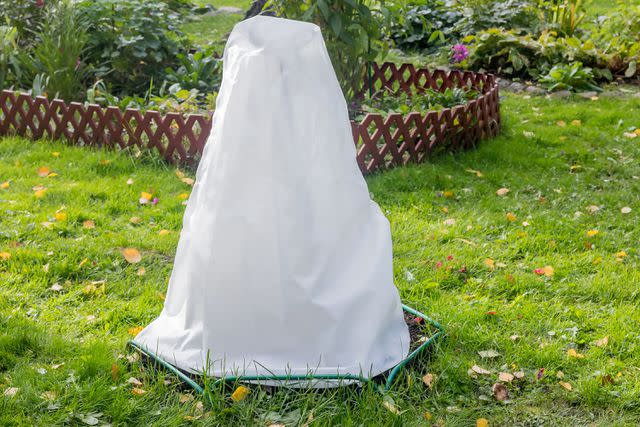How to Protect Plants From Frost
When the big chill is on, your plants may need a little TLC to thrive next season.
When your garden goes dormant for the winter, some of your plants might need a little extra tuck-in before the first frost hits. For more tender perennials or shrubs—or new seedlings in early spring—you'll need to learn the strategies to help you protect your plants from frost.

Ludmila Kapustkina/Getty Images
Know What Plants Need Frost Protection
Not all plants need extra protection from the frost—and what you'll need to keep covered depends on your USDA growing zone. "Plants that are most sensitive to frost are tender perennials, plants at the northernmost range of their winter hardiness, and plants that set buds in late winter or early spring," says Colin Kirk, New York Botanical Garden's Marjorie Rosen Manager of Outdoor Gardens.
Related: Plant Hardiness Maps Have Changed: Here's What You Need to Know
To help reduce the need for covering your plants in the fall, fill your garden with native plants and plants that fit squarely in your growing zone. Native plants have learned to love your local conditions—including your winters—and can thrive just fine with whatever the local winter throws their way.
Focus on Leaves and Mulch
Protect the roots from freezing with some ground cover as a first step. You can use traditional mulch (Kirk favors shredded cedar mulch), or simply let the dead leaves sit in the garden to protect your plants. "There’s a lot of beneficial qualities for the leaves that fall into the garden bed: they deposit carbon and nitrogen as they decompose, provide food and habitat for pollinators and beneficial fungi as they decompose, and act as an extra layer of insulation," Kirk says.
Related: Why You Should Cross Raking Off of Your To-Do List
If you're doing early spring planting, a generous layer of mulch can also help protect against late frosts, too.
Kirk recommends following the "lasagna method," where he places a layer of compost and a layer of mulch over the fallen leaves in November or December. "It gives my gardens that classic mulched look while aerating, feeding, and insulating the soil underneath it."
Use Burlap and Twine
Traditional burlap and twine is a great way to protect tender trees. "You should only burlap woody plants that need an extra layer of winter protection, especially deciduous plants—plants that lose their leaves—in the northern reaches of its hardiness zone or conifers near roads that might get salted frequently during the winter," says Kirk.
You may feel like you're suffocating your tree or shrub by keeping it under wraps all winter long, but trees should overwinter just fine without much sunlight. Deciduous trees have gone into a dormant period where photosynthesis is low—so there is little need to expose them to sunlight. "Wrapping and unwrapping them every day can actually damage a plant in the long run," Kirk says. "One risks snapping branches, aborting buds, and stressing the plant with a greater variation of temperature ranges."
Try a Cold Frame for Spring Seedlings
If you're someone who transplants seedlings in early spring and worries about a late frost destroying your tender shoots, a cold frame is your friend. "Cold frames are certainly an option if you’re trying to start vegetables earlier in the season," Kirk says.
Consider Alternative Frost Protection Options
Some gardeners use grow pots to protect bulb shoots and tender plants from spring frosts, and there are special, reusable covers you can buy to protect plants from frost—though burlap is also reusable year after year.
Some people have used other fabric, such as old bedding or quilts. Kirk recommends steering clear of plastic, as it has a very particular use in gardening. "Plastic bags keeps plants from transpiring and respirating by keeping condensation and humidity levels high around them," Kirk says. "Plastic bags as used more for grafting and tropicals, not for protection against frost or winter."
Don't Stress if Your Plant Looks Dead
Some plants look a little worse for the wear after a long winter. But be patient, as many can and will regrow with a little time and TLC. "Sometimes when a plant looks dead, it’s really only died back to its crown or roots. Look for suckering at the base of a plant before deciding to remove something from the garden," Kirk says.
Plant Perennials in the Fall
Related: How to Know When to Use Perennials or Annuals in Your Garden
For the hardiest perennial plants and trees, Kirk recommends skipping the spring planting season and opting for fall instead for everything but broad-leaved evergreens. "This allows the plant to establish itself without immediately facing the heat and drought stress of summer," he says.
For more Real Simple news, make sure to sign up for our newsletter!
Read the original article on Real Simple.

